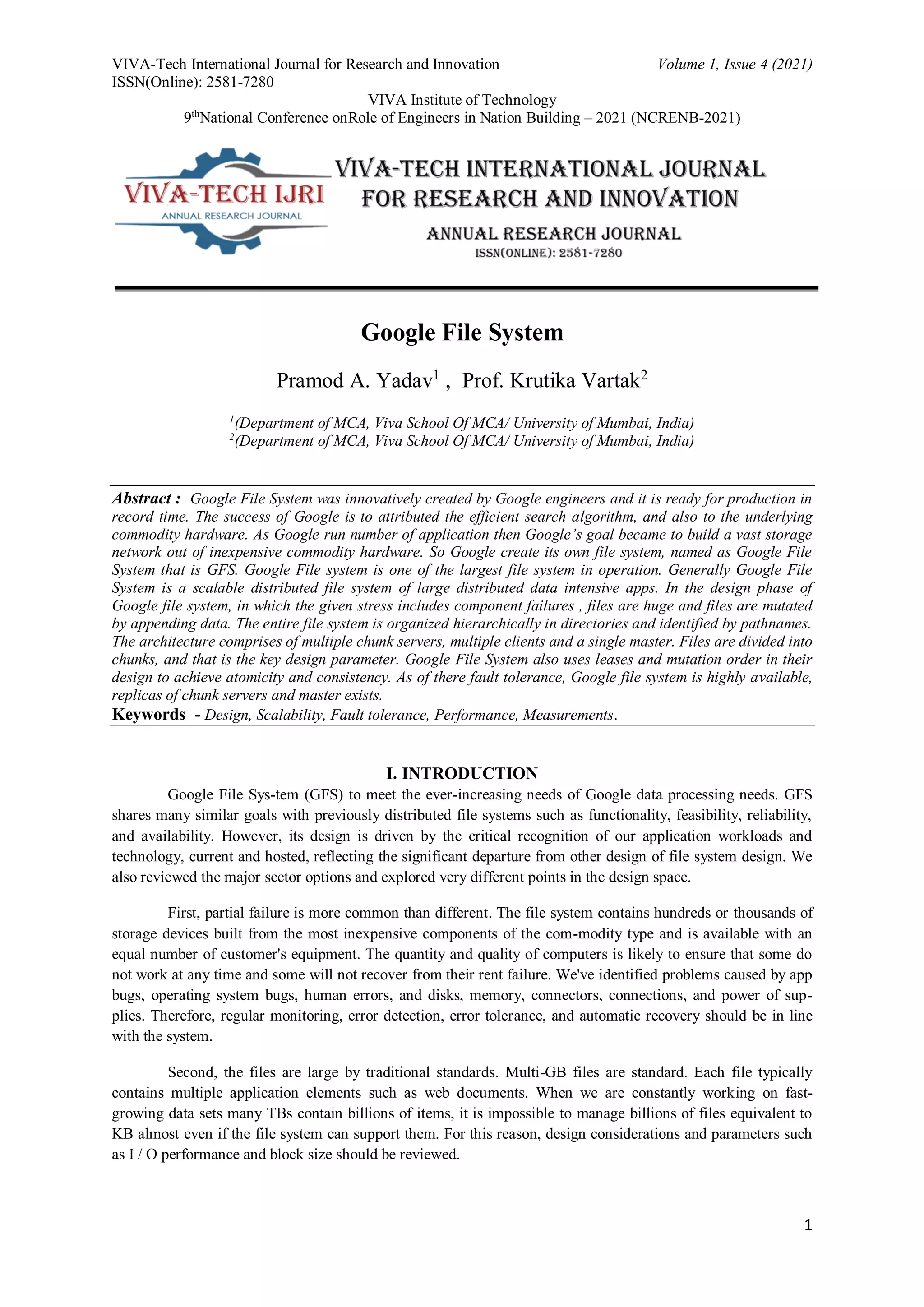The document discusses the Google File System (GFS), which was designed by Google engineers to meet the demands of large-scale data processing, characterized by its scalability, fault tolerance, and performance. GFS employs a hierarchical architecture made up of chunk servers, clients, and a single master, facilitating efficient data management through mechanisms like leases, data flow management, atomic record appends, and garbage collection. The system ensures high availability and reliability, utilizing replication and fast recovery strategies to handle component failures common in distributed environments.





![VIVA-Tech International Journal for Research and Innovation Volume 1, Issue 4 (2021)
ISSN(Online): 2581-7280
VIVA Institute of Technology
9th
National Conference onRole of Engineers in Nation Building – 2021 (NCRENB-2021)
6
ACKNOWLEDGEMENTS
I thank my college for giving us the opportunity to make this project a success. I offer my special thanks and
sincerity.
I thank Professor Krutika vartak for encouraging me to complete this research paper, for guidance and assistance
for all the problems I encountered while doing research.Without his guidance, I would not have completed my research
paper.
REFERENCES
[1] Thomas Anderson, Michael Dahlin, Jeanna Neefe, David Patterson, Drew Roselli, and Randolph Wang. Serverless
network file systems. In Proceedings of the 15th ACM Symposium on Operating System Principles, pages 109–126,
Copper Mountain Resort, Colorado, December 1995.
[2] Remzi H. Arpaci-Dusseau, Eric Anderson, Noah Treuhaft, David E. Culler, Joseph M. Hellerstein, David Patterson,
and Kathy Yelick. Cluster I/O with River: Making the fast case common. In Proceedings of the Sixth Workshop on
Input/Output in Parallel and Distributed Systems (IOPADS ’99), pages 10–22, Atlanta, Georgia, May 1999.
[3] Luis-Felipe Cabrera and Darrell D. E. Long. Swift: Using distributed disk striping to provide high I/O data rates.
Computer Systems, 4(4):405–436, 1991.
[4] Garth A. Gibson, David F. Nagle, Khalil Amiri, Jeff Butler, Fay W. Chang, Howard Gobioff, Charles Hardin, Erik
Riedel, David Rochberg, and Jim Zelenka. A cost-effective, high-bandwidth storage architecture. In Proceedings of
the 8th Architectural Support for Programming Languages and Operating Systems, pages 92–103, San Jose,
California, October 1998.
[5] John Howard, Michael Kazar, Sherri Menees, David Nichols, Mahadev Satyanarayanan, Robert Sidebotham, and
Michael West. Scale and performance in a distributed file system. ACM Transactions on Computer Systems,
6(1):51–81, February 1988.
[6] InterMezzo. http://www.inter-mezzo.org, 2003.
[7] Barbara Liskov, Sanjay Ghemawat, Robert Gruber, Paul Johnson, Liuba Shrira, and Michael Williams. Replication
in the Harp file system. In 13th Symposium on Operating System Principles, pages 226–238, Pacific Grove, CA,
October 1991.
[8] Lustre. http://www.lustreorg, 2003.
[9] David A. Patterson, Garth A. Gibson, and Randy H. Katz. A case for redundant arrays of inexpensive disks (RAID). In
Proceedings of the 1988 ACM SIGMOD International Conference on Management of Data, pages 109–116, Chicago,
Illinois, September 1988.
[10] rank Schmuck and Roger Haskin. GPFS: A shared-disk file system for large computing clusters. In Proceedings of the
First USENIX Conference on File and Storage Technologies, pages 231–244, Monterey, California, January 2002.
[11] Steven R. Soltis, Thomas M. Ruwart, and Matthew T. O’Keefe. The Gobal File System. In Proceedings of the Fifth
NASA Goddard Space Flight Center Conference on Mass Storage Systems and Technologies, College Park, Maryland,
September 1996.
[12] Chandramohan A. Thekkath, Timothy Mann, and Edward K. Lee. Frangipani: A scalable distributed file system. In
Proceedings of the 16th ACM Symposium on Operating System Principles, pages 224–237, Saint-Malo, France,
October 1997.](https://image.slidesharecdn.com/191-210802105707/75/Google-File-System-6-2048.jpg)